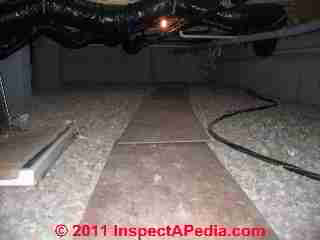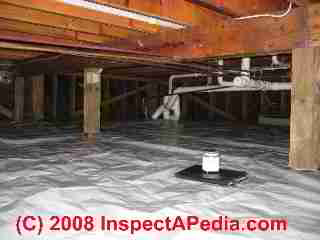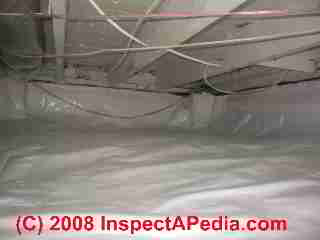 Crawl Space Moisture Barriers
Crawl Space Moisture Barriers
Where & how to put a water or moisture barrier in crawl spaces
- POST a QUESTION or COMMENT about how to dry out a wet crawl space & prevent future crawl space water entry
Stop crawl space water entry & control crawl space moisture using moisture barriers:
Plastic or other materials placed on crawl space floor and sometimes foundation walls can make a big difference in crawl space moisture levels. But for a crawl area moisture barrier to work successfully, additional steps both inside and outside the building are also recommended.
This article series describes the steps needed to get into, inspect, clean, and then dry out a building crawl space.
InspectAPedia tolerates no conflicts of interest. We have no relationship with advertisers, products, or services discussed at this website.
How to Keep Out Crawl Space Water & Moisture - Interior Measures for Crawl Space Moisture Control
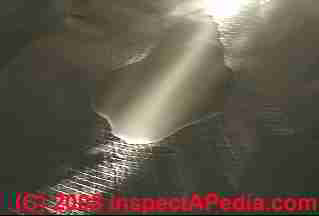 Here we focus on measures to take inside the crawl space to help keep that area dry.
Here we focus on measures to take inside the crawl space to help keep that area dry.
Watch out: as we detail at CRAWL SPACE SAFETY ADVICE, entering a wet crawl area is dangerous, involving shock hazards and possible chemical or sewage contaminants.
And see our complete list of crawl space dryout steps at
CRAWL SPACE DRYOUT
Crawl Space Surface Slope & Drainage Specifications
Be sure that the dirt floor moisture barrier slopes to a drain.
Before putting down plastic to keep moisture down in a crawl space, be sure that the crawl space floor surface is smooth - we don't want puddles of water below nor above a poly vapor barrier that we may be planning to put down.
[Click to enlarge any image]
In addition, it's important that the smooth crawl space floor surface also slope gently towards one or more drain points where, if necessary, you'll be able to install sump pumps to remove any water that might enter in the future. Slope on the crawl space floor can be as little as 1/8" per foot.
A great many installations we see, even in company product literature, show multiple low spots in a crawl space, each of which is subject to ponding and water retention from leaks or other unanticipated water entry into a crawl space or basement.
See CRAWL SPACE GROUND COVERS for details.
Crawl Space Floor & Wall Moisture Barriers: When, Where, How, & Why to Install Moisture Barriers, Heat & Dehumidification Equipment in the Crawl Space
Provide a moisture barrier over any dirt or gravel crawl space floors and extending up foundation walls but not up to nor in contact with wood framing or sills.
Moisture barriers may be 6-mil poly or other special basement sealer products such as special moisture-sealing concrete coatings.
The crawl space moisture barrier system shown here uses mechanical fasteners and adhesive to secure the plastic barrier to the foundation walls near the tops (but short of wood framing to reduce insect attack risk).
We install moisture barriers to stop the "pumping action" that draws moisture into a building through the foundation walls or through the crawl space dirt or concrete floor.
Crawl space moisture pumping occurs as moisture evaporates off of the indoor surface into building air. This process invites movement of additional water molecules through the outside surfaces and into the building.
Should the crawl space plastic go under or on top of the gravel in a crawl space?
Some installers like to put down the plastic then cover it with gravel, arguing that the gravel will "protect" the plastic from damage. That approach is shown at left.
In our opinion, placing gravel on top of the crawl space plastic is a bad idea.
- First, gravel on top of the plastic won't work well. The gravel, especially sharp gravel, is more likely to puncture the plastic ground cover.
- Second, if gravel is on top of the plastic we can't see that the plastic was placed over an adequately smooth sloped crawl space floor - the risk is future puddles of water that collect on top of the plastic but hidden from view under the gravel - an ongoing crawl space water and moisture trap.
- Third, we can't even see the plastic to know that it was properly placed and is continuous.
As you may have noticed in our first photo at the start of this section
KEEP OUT CRAWL SPACE WATER & MOISTURE,
if you can see the plastic you will see any puddles that are forming on top of it.
Use heavy 6-mil poly or stronger plastic on top of whatever else is on the crawl space floor, and walk or crawl with care.
Also see CRAWL SPACE GROUND COVER.
Choose your crawl space plastic vapor barrier material carefully.
Some plastics can give off an obnoxious odor themselves - an effect which may become suddenly noticeable and more significant than you anticipated once you've spread a smelly plastic out over a large crawl space area below a building.
It may take some time for such odors to dissipate. (We don't have data on possible health effects of the volatiles and gases comprising the odor from smelly plastic vapor barriers. Contact us if you do.)
The white reinforced plastic material shown in the photos here was not producing any noticeable smells at the time of our inspection.
Our photo shows a successful cleanup of a very moldy crawl area that had a gravel and dirt floor. The framing was cleaned, dried, then sealed with a Fosters™ clear fungicidal encapsulant, and a heavy poly vapor barrier was placed on the crawl area floor and sealed neatly throughout.
Even high quality workmanship such as this job may not last however, if the building owners do not take the outside steps to keep water out of the crawl area.
See CRAWL SPACE GROUND COVERS for additional details about choosing ground cover material for a crawl space and about installing it effectively.
Advice About Pouring (Placing) Concrete on Crawl Space Floors
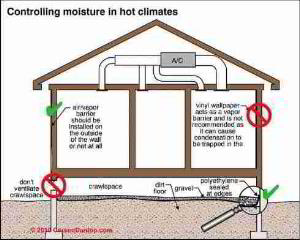
Moisture warning when installing concrete in a crawl space: Poured concrete or similar dense coating on crawl space floors and lower walls is a crawl space sealing and cleaning process offered by some mold and flood damage remediators as an alternative to the plastic vapor barrier.
Before pouring concrete or similar coatings into a confined space under a building you should determine if the surge of moisture that will be generated under the building is going to be a problem for other building areas.
If so, you'll need to take steps to direct that moisture outside rather than up through the building.
The sketch of the role of a dirt floor crawl space in building moisture and mold problems (above) is courtesy of Carson Dunlop Associates, a Toronto home inspection, education & report writing tool company [ carsondunlop.com ]. In hot humid climates, venting a crawl space is actually asking for trouble: moisture-laden warm air entering a crawl space leads to accumulated condensation and water and to a building moisture and often building mold problem.
Watch out: It is almost always preferable to keep water from entering a building rather than allowing it to enter and then working to get rid of it. But if you are going to do something permanent like pour a crawl space slab, and if your building has had chronic crawlspace water entry, consider including the measures described
It is much less costly to install a perimeter drain system before a concrete slab has been poured than afterwards.
This article series describes the steps needed to get into, inspect, clean, and then dry out a building crawl space.
We give a step by step crawl space entry, inspection, cleanout, dryout and keep dry guide explains how to get into or inspect a crawl space even if there is no ready access, how to assess crawl space conditions, how to stop water that is entering the crawl area, how to dry out the space, how to clean up and if necessary disinfect or sanitize the crawl space, and how to keep out crawl space water and moisture in the future.
Crawl Space Moisture Barrier Research & Specifications
- [1] Harriet Burge, Harvard School of Public Health, and EM Laboratory, a private mold and environmental testing lab - email to D.F. August, 2004. Dr. Burge is an educator, writer, and consultant in the field of indoor air quality and mold contamination.
- [2] Product literature and MSDS sheets for the biocides and fungicidal sealants listed in this article.
- [3] US Centers for Disease Control, CDC: www.cdc.gov/ncidod/diseases/hanta/hps/ describes the risks associated with hantavirus.
- [4]U.S. City or State Adopted versions of the model buiding code produced by ICC Section R408, Under Floor Space, http://publicecodes.cyberregs.com/icod/irc/2012/icod_irc_2012_4_sec008.htm, retrieved 3/2/2013
See IRC Section M1305.1.4 [PDF] Section M1305.1.4 for access requirements where mechanical equipment is located under floors. - [5]U.S. City or State Adopted versions of the model buiding code produced by ICC Section R406, Foundation Waterproofing and Dampproofing, http://publicecodes.cyberregs.com/icod/irc/2012/icod_irc_2012_4_sec006.htm, retrieved 3/2/2013
- Thanks to reader C. Brown for suggesting the need for detail about rapid dryout procedures for a wet crawl space
- PLASTIC MOISTURE BARRIER FLAME SPREAD
- WEATHER RESISTIVE BARRIERS [PDF] U.S. Department of Energy, ", how to select and install housewrap and other types of weather resistive barriers
...
Continue reading at CRAWL SPACE VAPOR BARRIER LOCATION or select a topic from the closely-related articles below, or see the complete ARTICLE INDEX.
Or see these CRAWL SPACE MOISTURE BARRIER FAQs - questions and answers posted originally on this page
Or see these
Recommended Articles
Suggested citation for this web page
CRAWL SPACE MOISTURE BARRIERS at InspectApedia.com - online encyclopedia of building & environmental inspection, testing, diagnosis, repair, & problem prevention advice.
Or see this
INDEX to RELATED ARTICLES: ARTICLE INDEX to CRAWL SPACES
Or use the SEARCH BOX found below to Ask a Question or Search InspectApedia
Ask a Question or Search InspectApedia
Try the search box just below, or if you prefer, post a question or comment in the Comments box below and we will respond promptly.
Search the InspectApedia website
Note: appearance of your Comment below may be delayed: if your comment contains an image, photograph, web link, or text that looks to the software as if it might be a web link, your posting will appear after it has been approved by a moderator. Apologies for the delay.
Only one image can be added per comment but you can post as many comments, and therefore images, as you like.
You will not receive a notification when a response to your question has been posted.
Please bookmark this page to make it easy for you to check back for our response.
Our Comment Box is provided by Countable Web Productions countable.ca
Citations & References
In addition to any citations in the article above, a full list is available on request.
- In addition to citations & references found in this article, see the research citations given at the end of the related articles found at our suggested
CONTINUE READING or RECOMMENDED ARTICLES.
- Carson, Dunlop & Associates Ltd., 120 Carlton Street Suite 407, Toronto ON M5A 4K2. Tel: (416) 964-9415 1-800-268-7070 Email: info@carsondunlop.com. Alan Carson is a past president of ASHI, the American Society of Home Inspectors.
Thanks to Alan Carson and Bob Dunlop, for permission for InspectAPedia to use text excerpts from The HOME REFERENCE BOOK - the Encyclopedia of Homes and to use illustrations from The ILLUSTRATED HOME .
Carson Dunlop Associates provides extensive home inspection education and report writing material. In gratitude we provide links to tsome Carson Dunlop Associates products and services.


